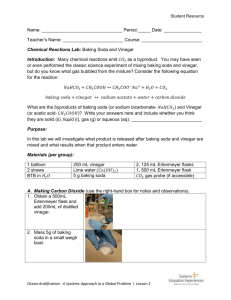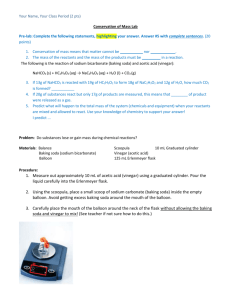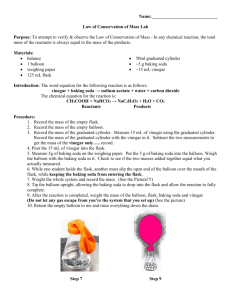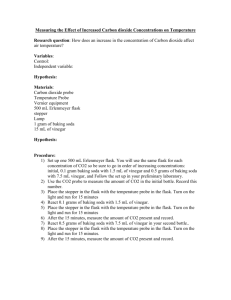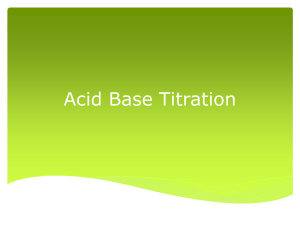ppt
advertisement
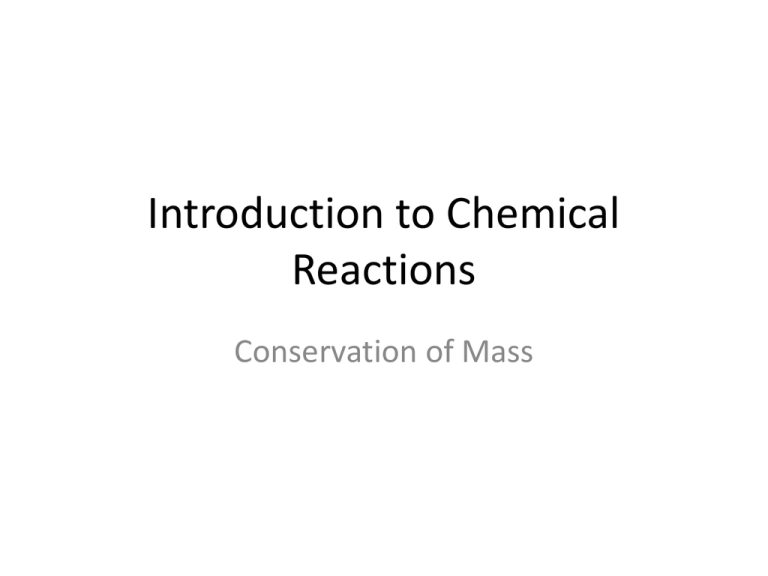
Introduction to Chemical Reactions Conservation of Mass If you add two substances together sometimes you get a chemical reaction. This is when a new substance is made. It is very difficult to reverse the reaction and get the original substances back. Signs that a chemical reaction has taken place include a change in colour, heat being given off or bubbles of gas being made. Adding acid to alkali Fireworks Ice cream melting x Driving a car Boiling the kettle x frying an egg Discuss in pairs which of The changes that are not these arex chemical reactions x chemical changes are called Lighting a matchphysical changes Burning a candle Printing x Melting candle wax Dissolving sugar in tea Making ice cubes Ironing clothes x x Baking a cake Launching a space rocket Instructions – Closed System 1. 2. 3. 4. 5. 6. Measure about 30mL of vinegar (acetic acid) into a small Erlenmeyer flask. Using your scoopula, place a small amount of baking soda into your balloon. Carefully place the balloon over the mouth of the flask making sure the baking soda does not fall into the flask YET. Using a balance, measure and record the total mass of the assembly. Tip the balloon up and empty its contents into the flask – make sure your balloon does not come off. Record your observations. Once the reaction has stopped, measure and record the mass of the assembly again. • Questions 1. What evidence of a chemical change did you notice? 2. Compare the total mass of the Erlenmeyer flask/balloon assembly before and after the reaction. What do you notice? Investigation 1: Open System 1. 2. 3. 4. 5. 6. 7. 8. Measure about 30mL of vinegar (acetic acid) into a small Erlenmeyer flask. Using your scoopula, place a small amount of baking soda into your balloon. Carefully place the balloon over the mouth of the flask making sure the baking soda does not fall into the flask YET. Mass your assembly and record. Remove the balloon from your flask Empty the baking soda into the flask and record your observations. Once the reaction has stopped, record the mass of your balloon and flask. Clean your area. Questions – Open System • Questions: 1. Compare the total mass of the beaker/test tube assembly before and after the reaction. What do you notice? 2. Compare the results of the two experiments. What do you notice? Explain any difference. Law of Conservation of Mass • Total mass of reactants = total mass of products – Reactant are on the left side of the reaction arrow – Products are on the right side of the reaction arrow • Number of atoms in reactants = number of atoms in products – Atoms cannot be created nor destroyed in a chemical reaction. • All a chemical reaction is, is a rearrangement of the atoms from reactants to products. Practice • Eg. 1 – A solid has a mass of 35g. When it is mixed with a solution, a chemical reaction occurs. If the total mass of the products is 85g, what was the mass of the original solution? • Eg. 2 – When a forest fire occurs, the ashes that remain have a much lower mass than the trees that burned. Does this break the law of conservation of mass? Why or why not? • Eg. 3 – Solution A has a mass of 60g. Solution B has a mass of 40g. When they are mixed, a chemical reaction occurs in which a gas is produced. If the mass of the final mixture is 85g, what mass of gas was produced? Word Equations • Hydrogen gas is reacted with oxygen gas to form water vapour. • Word Equation: – Hydrogen gas + oxygen gas water vapour • Balanced Chemical Equation – 2H2(g) + O2(g) 2H2O(g) • Skeleton Equation – H2(g) + O2(g) H2O(g) • When dissolved beryllium chloride reacts with silver nitrate in water, aqueous beryllium nitrate and silver chloride powder are made. Aqueous beryllium chloride + aqueous silver nitrate aqueous beryllium nitrate + solid silver chloride.



